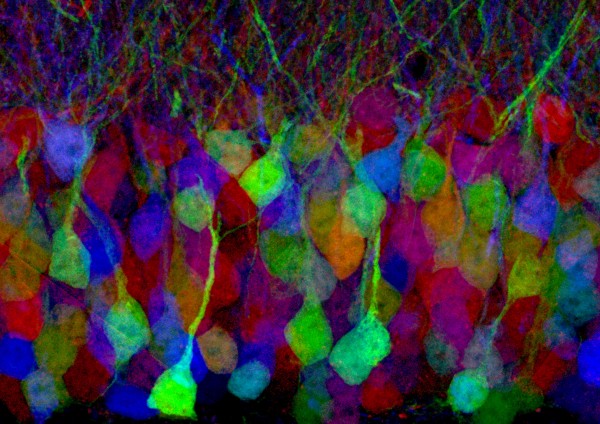

Courtesy Jeff Lichtman/Harvard University. Licence : CC BY NC ND 2.0. Source : https://flic.kr/p/5sEdqj
Chewing, breathing, and other regular bodily functions that we undertake “without thinking” actually do require the involvement of our brain, but the question of how the brain programs such regular functions intrigues scientists. Arlette Kolta, a professor at the University of Montreal’s Faculty of Dentistry, has shown that astrocytes play a key role. Astrocytes are star-shaped glial cells in our brain. Glial cells are not neurons – they play a supporting role. Kolta’s finding in fact challenges some of the beliefs scientists have about the way our brain works. Here, brain neurons are illustrated in a “brainbow.” The astrocytes are not shown.
Chewing, breathing, and other regular bodily functions that we undertake “without thinking” actually do require the involvement of our brain, but the question of how the brain programs such regular functions intrigues scientists.
A team lead by Arlette Kolta, a professor at the University of Montreal’s Faculty of Dentistry, has shown that astrocytes play a key role. Astrocytes are star-shaped glial cells in our brain. Glial cells are not neurons – they play a supporting role. The team’s finding in fact challenges some of the beliefs scientists have about the way our brain works.
The brain contains billions of cells and every brain function depends on the ability of neurons to communicate with each other. Neurons use an electrical language to communicate and the pattern of their electrical activity encodes the essence of the message that they convey to the next neuron.
“In the neuron-centric vision that dominates at the moment, changes in the pattern of neuronal electrical activity depend solely on the intrinsic properties of neurons and on the information they transmit to one another. Our results demonstrate that glial cells play a crucial role controlling the pattern of neuronal electrical activity and thereby neuronal functions,” Kolta said.
By using different methods to measure the electrical activity of neurons in the trigeminal system which enables sensation in the face and facial motor functions, the researchers were able to look at how the brain processes chewing.
“We discovered a mechanism by which astrocytes regulate the extracellular concentration of calcium in this sensory-motor circuit, and by doing this, determine the pattern of electrical activity of surrounding neurons. We think that the trigeminal neurons that we investigate have a dual function depending on the pattern of their electrical activity which can be either tonic or bursting,” explained Philippe Morquette, first author of the study. Tonic is like the hum when you pick up the phone, a continuous and permanent connection to the different parts of the system, while bursting is like the ringing you hear when you finish dialing. .
When neurons are in the tonic mode, they faithfully relay to other neurons information that they receive from sensory afferents. Sensory afferents are the means by which the brain and nervous system receive signals from the bodily senses. When they are in the rhythmic bursting mode they generate a rhythmic motor command, like the one needed to produce a repetitive movement such as chewing.
“The rhythmic bursting mode depends on activation of a current that is modulated by the extracellular concentration of calcium. We show that astrocytes are responsible for the switch from one mode to the other, and thus presumably from one function to the other. The switch cannot occur when astrocytes are ‘inactivated’ or when the described astrocytic mechanism is blocked. This mechanism relies on release of a specific calcium binding protein released by glial cells,” Morquette added.
Published in Nature Neuroscience on May 4, the study is the first to show the role that astrocytes play in regulating the concentration of calcium outside of neurons, bolstering the idea that these cells play an important role in neural processing. “The mechanism for regulating calcium that we described may have far reaching implications given the number of neuronal functions that may be altered by changes in extracellular calcium concentration and by the ubiquitous distribution of S100-beta, the calcium binding protein involved,” Morquette explained.
The importance of the findings is far greater than a better understanding of how we chew. “The mechanisms involved contribute to a wide variety of brain functions: they’re at the basis of other vital and repetitive movements like locomotion and respiration, they’re widespread in the cortex, hippocampus and other areas, and have been associated to many important functions such as attention and learning and memory. Finally, it is well known that astrocytes are over-activated in pathological situations associated with increased burst firing, like during seizures, and we believe that the mechanism described here is of particular relevance to those situations,” Kolta said.
About this study:
Philippe Morquette, Dorly Verdier, Aklesso Kadala, James Féthière, Antony G Philippe, Richard Robitaille and Arlette Kolta published “An astrocyte-dependent mechanism for neuronal rhythmogenesis” in Nature Neuroscience on May 4, 2015. Kolta and Morquette are affiliated with the Department of Neurosciences and Groupe de Recherche sur le Système Nerveux Central at University of Montreal’s Faculty of Medicine. Kolta is also affiliated with the university’s Faculty of Dentistry, and with the Réseau de Recherche en Santé Buccodentaire et Osseuse du Fonds de Recherche Québec-Santé. The study was financed by Canadian Institutes for Health Research (grant 14392). The University of Montreal is officially known as Université de Montréal.
Contact Information
William Raillant-Clark
International Press Attache
w.raillant-clark@umontreal.ca
Phone: 514-343-7593
Mobile: 514-566-3813















